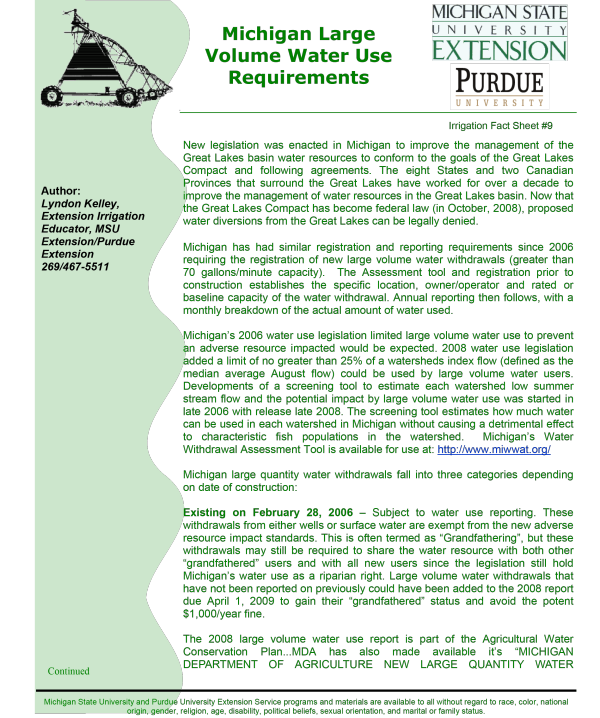
Bulletin Irrigation Fact Sheet #9
Michigan Large Volume Water Use Requirements
DOWNLOAD
August 18, 2009 - Lyndon Kelley
New legislation was enacted in Michigan to improve the management of the Great Lakes basin water resources to conform to the goals of the Great Lakes Compact and following agreements. The eight States and two Canadian Provinces that surround the Great Lakes have worked for over a decade to improve the management of water resources in the Great Lakes basin. Now that the Great Lakes Compact has become federal law (in October, 2008), proposed water diversions from the Great Lakes can be legally denied.
Michigan has had similar registration and reporting requirements since 2006 requiring the registration of new large volume water withdrawals (greater than 70 gallons/minute capacity). The Assessment tool and registration prior to construction establishes the specific location, owner/operator and rated or baseline capacity of the water withdrawal. Annual reporting then follows, with a monthly breakdown of the actual amount of water used.
Michigan’s 2006 water use legislation limited large volume water use to prevent an adverse resource impacted would be expected. 2008 water use legislation added a limit of no greater than 25% of a watershed's index flow (defined as the median average August flow) could be used by large volume water users. Developments of a screening tool to estimate each watershed low summer stream flow and the potential impact by large volume water use was started in late 2006 with release late 2008. The screening tool estimates how much water can be used in each watershed in Michigan without causing a detrimental effect to characteristic fish populations in the watershed. Michigan’s Water Withdrawal Assessment Tool is available for use at: http://www.miwwat.org/
Michigan large quantity water withdrawals fall into three categories depending on date of construction:
Existing on February 28, 2006 – Subject to water use reporting. These withdrawals from either wells or surface water are exempt from the new adverse resource impact standards. This is often termed as “Grandfathering”, but these withdrawals may still be required to share the water resource with both other “grandfathered” users and with all new users since the legislation still hold Michigan’s water use as a riparian right. Large volume water withdrawals that have not been reported on previously could have been added to the 2008 report due April 1, 2009 to gain their “grandfathered” status and avoid the potent $1,000/year fine.
The 2008 large volume water use report is part of the Agricultural Water Conservation Plan...MDA has also made available its “MICHIGAN DEPARTMENT OF AGRICULTURE NEW LARGE QUANTITY WATER WITHDRAWAL REGISTRATION FORM”. Contrary to its title this form could be used to register withdrawals that were constructed prior to February 28, 2006 by filling in the date constructed. The reporting and registration forms are available at http://www.michigan.gov/mda/0,1607,7-125-1567_1599_29980-89238--,00.html
February 28, 2006 through July 8, 2009 – For new or increased large quantity withdrawals developed in this period, there is a rebuttable presumption that the withdrawal will not cause an adverse resource impact if (a) it is located more than 1,320 feet from the banks of an affected stream reach, or (b) the well is at least 150 feet deep. Water use reporting is required. As mentioned above, voluntary registration of these withdrawals will help to improve the cumulative impact accounting procedure. Registration forms for withdrawals constructed in this time frame are available at: http://www.michigan.gov/documents/mda/MDA_NewLQW_RegistrationForm_181528_7.pdf. . Withdrawals planned in the next 18 months can also be registered in “Michigan’s Water Withdrawal Assessment Tool” if the withdrawal receives a favorable assessment. By law beginning February 28, 2006, a person shall not make a new or increased large quantity withdrawal that causes an adverse resource impact. A person who knowingly makes a new or increased large quantity withdrawal that causes an adverse resource impact may be subject to a civil fine of not more than $10,000.00 per day of violation. Falsifying a record submitted in this process may result in a civil fine of not more than $1,000.00.
On and after July 9, 2009 – Large quantity water withdrawals proposed after July 8, 2009 must receive a favorable assessment from “Michigan’s Water Withdrawal Assessment Tool” or an approval from a requested site-specific review by the MDEQ and be registered before proceeding. If a site-specific review by the MDEQ or an evaluation by the Water Withdrawal Assessment Tool determines that a proposed withdrawal is a zone A or a zone B withdrawal, there is a rebuttable presumption that the withdrawal, as specified in the review or tool, will not cause an adverse resource impact. As previously stated penalties are in place for causing an adverse resource impact.
An overview of procedure to establish new large volume withdrawals:
- Determine needed pumping capacity and probable location for the new withdrawal.
- Work through the Michigan Large Volume Water Withdrawal Assessment Tool (MiWWAT) for a determination, (http://www.miwwat.org/).
- If the MiWWAT assessment is green (zone A) or yellow (zone B) you can proceed to register your proposed water withdrawal. Building can happen in the following 18 months and any small modification can be noted by returning to the tool and modifying your original request.
- If the MiWWAT assessment is orange (zone C) or red (zone D) try to modify location or well depth to reduce stream flow impact. If more favorable assessment cannot be achieved a Site Specific Review may be requested from Michigan Department of Environmental Quality through the MiWWAT tool.
- If the MDEQ Site Specific Review does not provide a favorable registration to proceed, land owner may initiate a meeting of the Large Volume Water Users in the watershed to investigate reduction in water use by fellow large volume water users.
- If the meeting of Large Volume Water Users does not provide MDEQ with sufficient reductions in use by other riparian to allow the proposed water use civil court action may be necessary to establish the riparian right to water use for the parcel.



 Print
Print Email
Email



